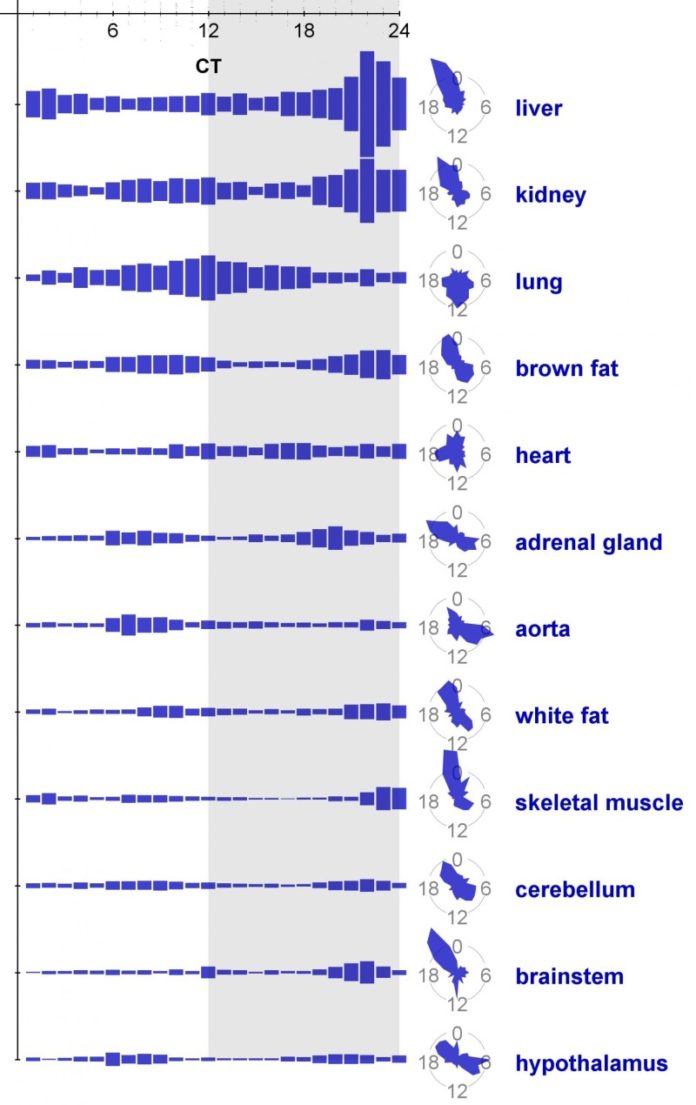
A new effort mapping 24-hr patterns of expression for thousands of genes in 12 different mouse organs — five years in the making — provides important clues about how the role of timing may influence the way drugs work in the body. A study detailing this veritable “atlas” of gene oscillations, never before described in mammals, is published this week in the Proceedings of the National Academy of Sciences. The research was led by John Hogenesch, PhD, professor of Systems Pharmacology and Translational Therapeutics, in the University of Pennsylvania’s Perelman School of Medicine.
The 24-hour rhythms of gene and protein activity govern most biological processes in animal and plant life on Earth. The Penn team found that nearly half of all genes in the mouse genome oscillate on a 24-hour schedule somewhere in the mouse body.
The team didn’t stop there. They also determined that the majority of best-selling drugs (based on U.S. sales data from Q1 2013 at Drugs.com) target proteins made from genes whose expression changes daily.
Timing is an important but underappreciated factor in drug efficacy. “Many of these drugs have relatively short half lives in the body,” notes Hogenesch. The team suggests that the intersection of atlas and drug data can predict which drugs might benefit from timed dosing — “the essential medicines that directly target the products of rhythmic genes and therefore proteins.” This approach is the crux of a growing field called chronotherapy. What’s Under the Lamppost
“The genome is under much more clock control than we once thought,” explains Michael Hughes, PhD, a former postdoctoral researcher in the Hogenesch lab, who is now an assistant professor of Biology at the University of Missouri-St. Louis. “Since only a few organs were studied previously, we were only looking under the lamppost. Now we have the most comprehensive survey to date.”
Specifically, the team found that 43 percent of all protein-coding genes showed circadian rhythms in being transcribed into proteins somewhere in the mouse body. The liver was the most rhythmic, having more oscillating genes than any other organ studied. They also found that these oscillations largely occur in an organ-specific manner, with the expression of many oscillating genes peaking during “rush hours” of transcription (that is, the reading of DNA onto RNA before proteins are made by the cell) preceding dawn and dusk. The non-coding RNAs conserved between mouse and humans show a rhythmic expression in similar proportions as protein-coding genes, helping the researchers to focus on the non-coding genes most likely to be relevant in humans.
Drug targets are even more likely to be under clock control — 56 of the 100 top-selling drugs and 119 of the 250 World Health Organization’s list of essential medicines work on genes with circadian oscillation. “Most of these drug targets were not known to be clock-regulated. Many metabolizing enzymes and transporters are too,” says Hogenesch. “Because this isn’t appreciated, few of these drugs have been evaluated for time-of-day dependent efficacy, metabolism, or toxicity.”
The study of drug timing has been going on for forty years and has had several successes like chemotherapeutics, short-acting statins, and low-dose aspirin. However, most of these studies were done by trial and error. “Now we know which drug targets are under clock control and where and when they cycle in the body. This provides an opportunity for prospective chronotherapy,” explains Hogenesch. Benefits of proper drug timing could include better compliance, improved efficacy, fewer drug:drug interactions, and ultimately, better outcomes at lower costs.
Hognenesch notes that their next steps will be to apply this knowledge to specific animal models to look at time of effectiveness. Eventually, though, it will take rigorous clinical studies to determine optimal drug timing.
The group provides a web site to browse the data called CircaDB, http://bioinf.itmat.upenn.edu/circa/. There, researchers can search their favorite gene or find genes that cycle in tissues or organs of interest.
Story Source:
The above story is based on materials provided by Perelman School of Medicine at the University of Pennsylvania. Note: Materials may be edited for content and length.
Journal Reference:
- Ray Zhang, Nicholas F. Lahens, Heather I. Ballance, Michael E. Hughes, and John B. Hogenesch. A circadian gene expression atlas in mammals: Implications for biology and medicine. PNAS, October 2014 DOI: 10.1073/pnas.1408886111
